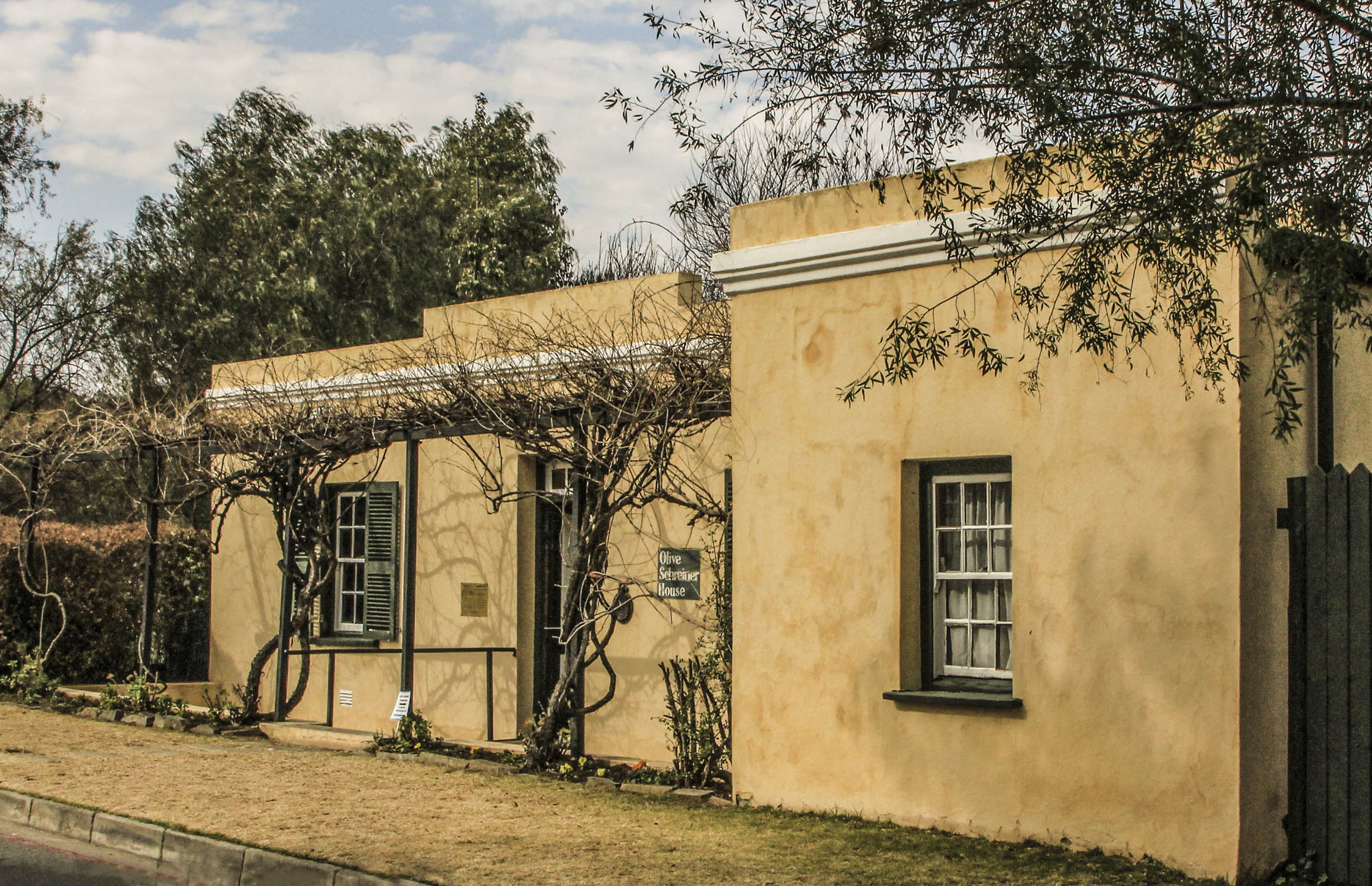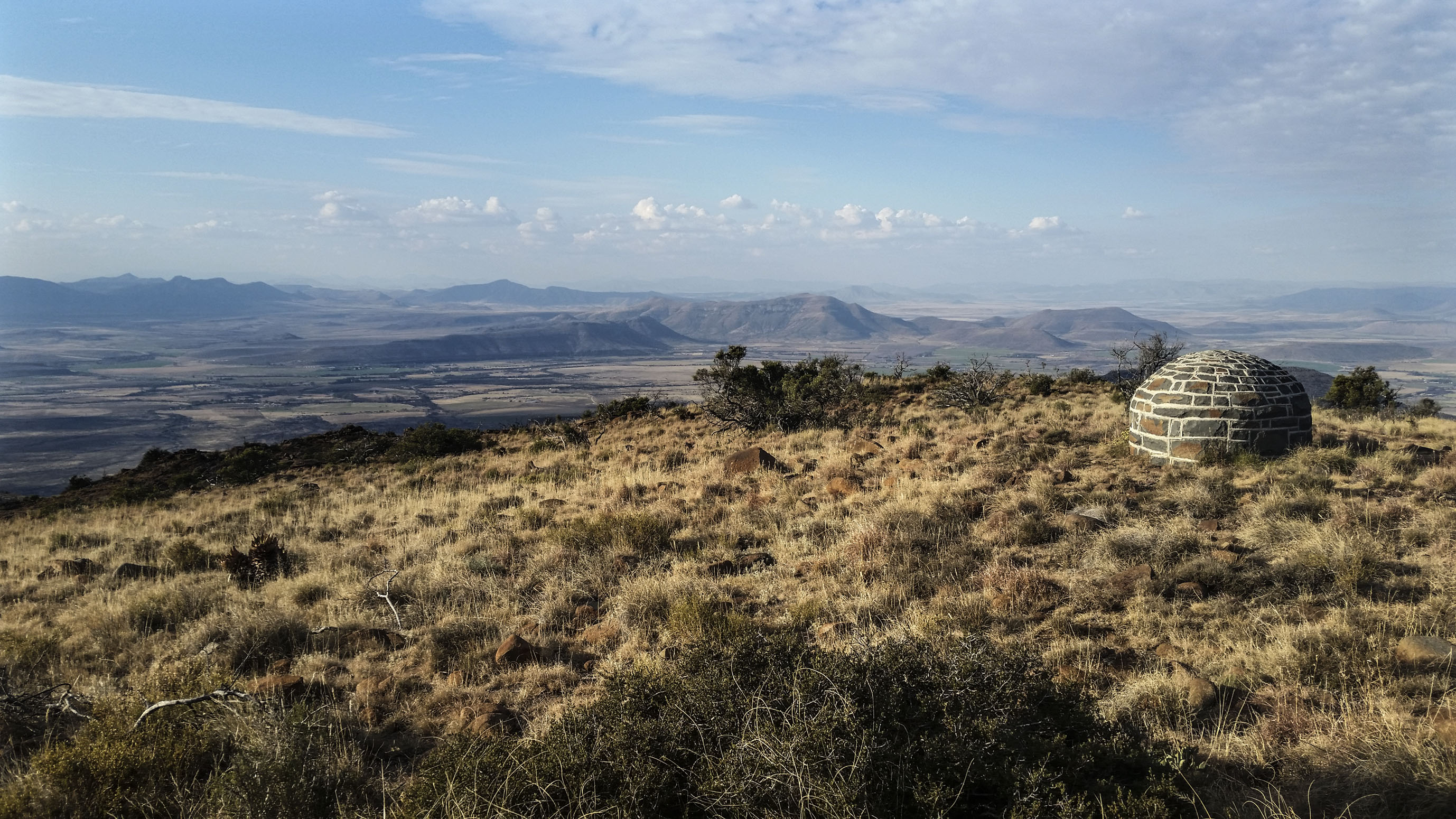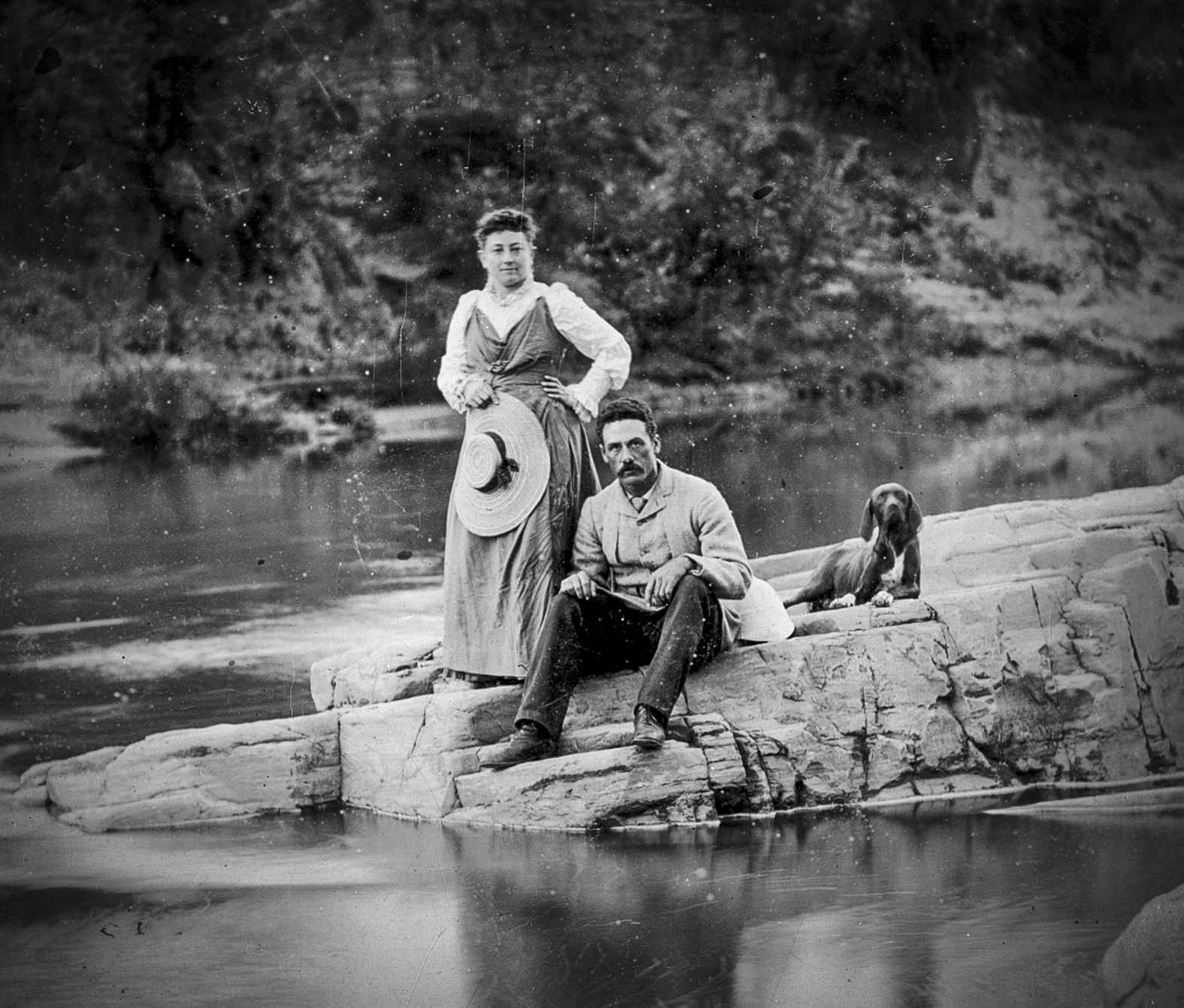Landscape for thought: Olive Schreiner grew up in the Karoo and lived in towns such as Cradock, viewed here from Oukop Hill. (Chris Marais)
With a long fascination for both the Karoo and storytelling, I have surprised myself by belatedly realising how little I knew of one of the greatest storytellers to come out of the Karoo. I speak of Olive Schreiner.
Many know The Story of an African Farm, published, to great acclaim, in the 1860s while she was still in her 20s. But, when we read Schreiner in a class I co-lead at the University of the Witwatersrand on narrative non-fiction, I was fascinated to learn of her strident non-fiction output championing pacifism, secularism, anti-imperialism, feminism and nonracialism, and tackling monopoly capitalism.
I began to wonder, as I devoured her writings and those of her biographers, if Schreiner was an early — perhaps the earliest — example of a decolonised mind?
What was soon apparent was that she was a nomad, endlessly on the move, both in South Africa and abroad, but that her most productive — and globally influential — work was done at some of the places she lived in the Karoo.
Her celebrity gave her access to the intelligentsia and the powerful, yet her ideal was the simple Karoo life with a plain room, a stretcher, table, chair and a primus for cooking. She wanted little clutter so as to maximise her time putting pen to paper and was known to do all-night writing benders.
I wanted to visit her Karoo places, to read her published works and letters, to reflect on a world view generations ahead of its time and on the landscape which shaped and nurtured the core of her thought — the inseparability of mind and body and the interconnectedness of all living things — which defined her writing and activism.
WITTENBERGEN
Olive, the ninth child of missionaries Gottlob and Rebecca Schreiner, was born at a mission station near the Lesotho border on March 24 1855.
At Herschel, a village near Lady Grey, I found an almost complete church. It was a Sunday and a small service was being held. A woman emerged. I asked if this was the Wittenbergen Mission. She said it was the new one; the old one was a few kilometres away. I said I was interested in Olive Schreiner. She replied: “I can show you the room where she was born.”
This was to be my experience as I crisscrossed the Karoo. Although Schreiner will have been dead for a century next year, residents today know where she lived and invariably have an anecdote to tell about her.
A Wittenbergen church elder and I drove a dusty road into a sheltered valley. Behind a large,rectangular rock-enclosed kraal was a church made from sandstone and a few other buildings.
A service was underway. Plaques on the wall of the church included a framed copy of the birth register from 1855, which recorded Schreiner’s birth.
A couple of matriarchs shepherded me to the manse alongside the church. The house was cavernous and bare, save for the odd carpet. We turned down a corridor and into an empty bedroom at the back of the house. “This is where she was born,” I was told with a certainty that did not allow me to ask how this was known to be the case.
The house had seemingly sucked every cold front to visit the area deep into itself. The woman in front of me gave a little shudder. We headed for the front door and the sunshine beyond.
 The home she shared with her brother Theo is now the Olive Schreiner House Museum, which has exhibitions about her life and work. (Chris Marais)
The home she shared with her brother Theo is now the Olive Schreiner House Museum, which has exhibitions about her life and work. (Chris Marais)
If you could imagine a setting where an intellect could be nurtured to challenge the tenets of its times, and I speak not of those of the Cape Colony but the entire British Empire, this would not be it. It is too isolated, then as now, too marginal.
Many of the stories of her childhood at Wittenbergen are not happy. Three of Olive’s male siblings, Oliver, Emile and Albert, died young.She was named Olive Emilie Albertina after them.
Martinet parents made life all but impossible for their offspring. While in the business of converting the heathen, they insisted on a caste-like order of humanity. Speaking Afrikaans, the language of lesser people, would bring a beating, such as described by Ruth First and Ann Scott in their seminal biography, Olive Schreiner, in 1980.
Writing during World War I, in The Dawn of Civilisation, Schreiner said her views were shaped while out in the veld “not yet nine years old”. Puzzled and heartbroken at the life around her, she wondered: “Why did everyone press on everyone and try to make them do what they wanted? Why did the strong always crush the weak? Why did we hate and kill and torture? Why was it all as it was? Why had the world ever been made? Why, oh why, had I ever been born?
“The sun began to rise.
“It shot its light across the long, grassy slopes of the mountains and struck the little mound of earth in the water. All the leaves and flowers and grasses on it turned bright gold, and the dewdrops hanging from them were like diamonds; and the water in the stream glinted as it ran.”
 Eternal view: Olive Schreiner is buried in a sarcophagus on Buffelskop with her husband Samuel Cronwright-Schreiner, their dog Nkita and their unnamed daughter. (Kevin Davie/M&G)
Eternal view: Olive Schreiner is buried in a sarcophagus on Buffelskop with her husband Samuel Cronwright-Schreiner, their dog Nkita and their unnamed daughter. (Kevin Davie/M&G)
At nine Olive’s younger sister, Ellie, just two, died.“I think I first had this feeling with regard to death clearly when my favourite little sister died when I was nine years old. I slept with her little body until it was buried, and after that I used to sit for hours by her grave, and it was impossible for me then, as it is impossible for me now, to accept the ordinary doctrine that she was living somewhere without a body,” she said, quoted in Life of Olive Schreiner, written by her husband Samuel Cronwright-Schreiner.
Ellie’s death, she said, made her a freethinker, rejecting formal religion for what we, today, would call agnosticism. First and Scott say freethinkers wer not that unusual in England then, but were usually at least in their 30s and 40s. “She was an adolescent, she was a girl and she had almost no formal education,” they say.
“What was extraordinary was that her crisis of faith had occurred in a particularly closed culture, in which a system of theology co-terminus with family authority had not yet been challenged.”
Photos show that her parents were an attractive couple. Gottlob failed as a missionary, being fired for trading — observers saying it was difficult to pay the bills on a missionary’s stipend. He failed later, too, as a trader. When Olive was just 10,her parents had to farm their children out to whoever would take them because they could not afford to look after them. Olive began a peripatetic existence, living with friends or family at Cradock, Barkly East, Hermon, Aliwal North, Dordrecht, New Rush (Kimberley) and Fraserburg.
 Belief in nature: Olive, Samuel and their dog enjoyed the outdoors. The dry Karoo climate helped Schreiner cope with her chronic asthma. (National English Literary Museum, Grahamstown)
Belief in nature: Olive, Samuel and their dog enjoyed the outdoors. The dry Karoo climate helped Schreiner cope with her chronic asthma. (National English Literary Museum, Grahamstown)
Joyce Berkman writes in The Healing Imagination of Olive Schreiner that, however remote from cultural centres, the young Schreiner gained access to the works of writers who were profoundly critical of ruling orthodoxies.
“When she was 16 Schreiner credited Spencer’s First Principles with resetting her ‘broken leg’, later saying Spencer ‘helped me believe in a unity underlying all nature’.
“By her late adolescence John Stuart Mill had supplanted Jesus as her moral philosopher,” say First and Scott.
Berkman says her voluminous reading included Mill, Spencer, Emerson, Plato, Shelley, Gibbon, Spinoza, Thoreau, Coleridge, Ruskin, Carlyle, Lecky, Goethe, Heine, Darwin and Huxley in non-fiction and Dickens, the Brontë sisters, George Sand and Browning in fiction, many of these works coming from the public library in Cradock, which today has a room named after her and which includes some of
the titles she borrowed back in the day.
Berkman says “none of these writers are sufficient to explain Schreiner’s objections to dominant British ethnic, racial, and gender conventions. Many of her favourite authors upheld notions of white and male privilege. The spirit of their works, more than the content, mattered to her: their brave quest for the truth, their love for humanity, belief insocial progress, and their willingness to suffer persecution.”
From the age of 15, Schreiner worked as a governess on farms, first in the Colesberg area and then around Cradock, completing The Story of an African Farm at Gannahoek. Cradock has a small, but excellent, museum in the house where she lived with her 23-year-old brother Theo (then the school headmaster), which captures their life and times.
Schreiner then moved to England intending to study to become a nurse, which did not work out —her fame and intellect giving her access to influential writers and thinkers. She returned to South Africa in late 1889, aged 34, to reconnect with the Karoo because its dry climate was kind to her asthmatic condition,which began in her late teens and plagued her for most of her life.
MATJIESFONTEIN
Between 1890 and 1892 she lived in Matjiesfontein, then and now a grand hotel and railway stationvillage, now about two-and-a-halfhours’ drive from Cape Town.
“It is all so bare, the rocks and the bushes, each busy standing separate from the others, alone by itself,” she wrote. The dry river bed behind the hotel, gnarly and primordially aged, became a “walking up and down place”.
Schreiner wrote a series of essays at Matjiesfontein published later as Thoughts on South Africa. First and Scott note these writings on race have a “curiously ambivalent exposition. At times Olive seems to be looking to a transformed society free of race oppression; at others, she seems to endorse the ideological justifications of white conquest.”
In 1894 Schreiner, aged 38, married Samuel Cronwright, a Cradock farmer eight years younger than her. He, unusually, added her surname to his. They lived briefly on his farm, Kranz Plaats, but moved to Kimberley because farming activities were said to have aggravated her asthma.
Sol Plaatje University’s Sabata-Mpho Mokae, who has written a biography on Plaatje and has published several novels in Setswana, took me to the Schreiner house where her daughter had died soon after birth. (Schreiner was to have six miscarriages after this.)
Plaatje was highly influential both as a writer and publisher and politically in that he was a founder of an organisation that became the ANC. Mokae said Plaatje named one of his daughters Olive after Schreiner and that she was the godmother to the child.
The couple were living in Berea, Johannesburg, in 1899, with war looming between the British and the Boer states. Schreiner wrote several anti-war pieces, siding with Boer interests against the imperial power. They left Johannesburg, as many did, ahead of the outbreak of war in 1899, living at Kareekloof, an isolated farm (now an upscale hunting lodge) near Strydenburg, in the Northern Cape.
Schreiner then moved to Wagernaarskraal (Beaufort West is the nearest town), which is still owned by the same family thathosted her. She wrote a famous anti-war poem here in 1900:
The Cry of South Africa
Give me back my dead!
They who by kop and fountain
First saw the light upon my rocky breast!
Give back my dead,
The sons who played upon me
When childhood’s dews still rested on their heads.
Give back my dead
Whom thou hast riven from me
By arms of men loud called from earth’s farthest bound
To wet my bosom with my children’s blood!
Give back my dead,
The dead who grew upon me!
HANOVER
Cronwright took up legal studies and opened an office at Hanover, a sleepy village on the N1. Here, the Schreiners lived with Nkita their dog and a family of meerkats, which she took for walks on the veld.
Hanover was under martial law, its most famous resident writing: “Some months later in the war when confined in a little up-country hamlet, many hundreds of miles from the coast and from Johannesburg, with the brunt of war breaking around us, De Wet having crossed the Orange River and being said to be within a few miles of us, and the British columns moving hither and thither, I was living in a little house on the outskirts of the village, in a single room, with a stretcher and two packing cases as furniture, and with my little dog for company.
“Thirty-six armed Africans were set to guard night and day at the doors and windows of the house. I was only allowed to go out during certain hours in the middle of the day to fetch water from the fountain, or to buy what I needed, and was not allowed to receive any books, newspapers or magazines.
“One was allowed neither to light a candle nor strike a match. When a conflict was fought nearby the dead and dying were brought in. Three men belonging to our village were led to execution; death sentences were read in our little market place; our prison was filled with our fellow-countrymen; and we did not know from hour to hour what the next would bring to any of us.
“Under these circumstances I felt it necessary I should resolutely force my thought at times to the horror of the world around me, to dwell on some abstract question, and it was under these circumstances that this little book was written.”
This is the foreword to Women and Labour. Berkman says the work became the bible for the women’s movement, arguing for the right of women to work.
AlthoughHanover has some charm, it hardly appears a centre of leading thought, but Woman and Labour is Schreiner’s answer to Karl Marx, it becoming a foundational document for the global suffragette movement and its demand for voting rights for women.
The Human Sciences Research Council’s chief executive, Crain Soudien, in a lecture at the University of Cape Town last year, said althoughracist views had dominated political life in South Africa for much of the colonial past, there had also been a counterweight to this view. From the late 1800s “the most provocative person pushing this counterweight was an extraordinary figure in our South African history, a young, white middle-class woman called Olive Schreiner.
“She was also one of the world’s first feminist novelists … but here she’s trekking around the hinterland dustlands of the Karoo,” said Soudien, explaining that Schreiner had influenced Cape Town-based intellectuals who turned the city into an alternative centre of what it means to be a human being. “It begins with Olive Schreiner,” he said.
Berkman writes: “Between 1890 and 1914 [Schreiner] emerged as the leading South African critic of British imperialism and the leading exponent of an independent, federalist, and democratic union of South Africa. In Closer Union, 1909, Schreiner defended the extension of the same political and economic opportunities to blacks as were available to whites.
“Unless such treatment prevailed, a host of horrors would befall the country. The suppressed talents of blacks would become ‘subterraneous and disruptive forces’,” says Berkman.
“Though in the short run white supremacist policies would ‘pay us admirably both to labour and lands’, benefits would be short-lived. If we raise the dark man we shall rise with him; if we kick him under our feet, he will hold us fast by them,” Schreiner wrote in Closer Union.
She died in a boarding house in Wynberg, Cape Town, aged 65 in December 1920 and is interredin a sarcophagus atop Buffelskop, near Cradock, which takes more thanan hour to get up to in a 4×4.
In the grave with her, in separate coffins, are Nkita, Samuel and their unnamed daughter.
The burial siteis surrounded in all directions by the seemingly timeless and endless Karoo.